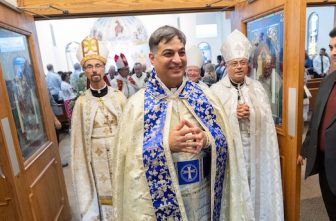
Editor’s note: This column is part of a series on holy orders and the first on the priesthood. It follows eight columns by Father Van Sloun on the ordination and ministry of deacons in the Church.
The priestly stole is the primary symbol of the ordained priesthood. It signifies the priest’s authority to preside over the sacraments and his desire to take upon himself the yoke of obedient service to Jesus, his master (Mt 11:29-30). It is a long, narrow strip of high-quality cloth usually made of cotton, wool or silk. It is typically 4.5 inches wide, about 9.5 feet long, and it may have a fringe or tassels at the end. It is placed around the back of the neck and hangs down the front of the body in equal lengths on the right and left sides. It is worn over the alb and under the chasuble or cope. Stoles come in each of the liturgical colors: white, green, red, violet and rose. The color chosen corresponds to the liturgical season, the Mass of the day or the sacrament being celebrated. Some stoles are plain while others are beautifully embroidered with spiritual symbols. Many stoles are designed as a set to match a chasuble.
A book is also a primary symbol for the priesthood. The book often has a cross on the cover or behind it, and sometimes it has a stole laying over it. The book may represent the entire Bible or an Evangelarium, the Book of the Gospels. The priest presides over the Liturgy of the Word, proclaims the Gospel when a deacon is not present, and is the usual preacher of the homily. The priest is a “man of the book,” one who reads and prays with the book daily, and one who preaches the book, who develops his homilies based on Scripture.
Sometimes the book has three tabs lettered with a “P,” in persona Christi, because the priest is in the person of Christ; an “F,” fidelitas, Latin for fidelity, because the priest is called to be faithful to Jesus and his Gospel; and “SS,” sometimes interpreted to stand for Sacred Scripture, because the priest is charged to know and preach the truths of Scripture, or to stand for Sancti Spiritu, Latin for the Holy Spirit, because the priest depends upon the guidance and inspiration of the Holy Spirit to pray with Scripture, understand it, and preach about it. Sometimes the book has seven tabs, usually understood to represent the seven sacraments.
A host, a chalice, or a host and chalice together are also symbols of the priesthood. Only a priest presides over the Liturgy of the Eucharist. The priest holds the host, the round piece of bread, and the chalice, which contains the wine, and when he raises them and pronounces the Words of Institution at the time of the consecration, by the power of God they are changed into the body and blood of Christ.
A censer is a vessel usually made of metal that contains burning charcoal, and when incense is added, fragrant smoke curls upward. Scripture says that the smoke represents prayer: “May my prayer be incense before you” (Ps 141:2) and “bowls filled with incense, which are the prayers of the holy ones” (Rev 5:8). The censer represents the priesthood because the priest leads the congregation in prayer and is the minister who most often uses the censer at Mass, Benediction and other liturgies. The priest is a representative for the people before God, and he prays on their behalf as he offers “gifts and sacrifices for sins” (Heb 5:1) and “prayers and supplications” (Heb 5:7). Censers were used by the priests of the Old Testament (Ex 30:7; Lv 10:1; Lv 16:12; Nm 16:6-7,17b-18; Nm 17:11,12) and by the priest Zechariah in the New Testament (Lk 1:9-11).
Folded hands represent prayer, and a priest is a man of prayer. A priest has the obligation to pray the Liturgy of the Hours each day (Canons 276.3 and 1174.1) and “is earnestly invited to offer the eucharistic sacrifice daily” (Canon 276.2). Archbishop Fulton Sheen was a vigorous proponent that priests make a daily Holy Hour based upon Jesus’ question to Peter, “So you could not keep watch with me for one hour?” (Mt 26:40).
A fishing net is a symbol for the priesthood because when Jesus called Simon Peter, he told him, “from now on you will be catching men” (Lk 5:10b). Similarly, when Jesus called Simon Peter and Andrew, he said, “Come after me, and I will make your fishers of men” (Mt 4:19; Mk 1:17), and he presumably spoke likewise to James and John (Mt 4:21-22; Mk 1:20). The apostles were commissioned to “make disciples of all nations” (Mt 28:19), to net new believers.
Crossed keys are a symbol of the priest’s authority to forgive sins, based upon the words originally spoken by Jesus to Peter: “I will give you the keys” and “whatever you loose on earth shall be loosed in heaven” (Mt 16:19), an authority later extended to all the Apostles (Mt 18:18).
Other symbols used for the priesthood include a cross, the preeminent symbol for Jesus, because a priest loves Jesus and patterns his life on him; a burning candle, because a priest is guided by Jesus, the light of the world, and because it represents the inspiration of the Holy Spirit; wheat and grapes, which often accompany the host and chalice; and an altar, because the priest presides at an altar.
Father Van Sloun is the director of clergy personnel for the Archdiocese of St. Paul and Minneapolis.




